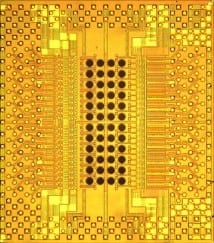
Research into a new type of laser will dramatically improve future devices used for sensing and in communications, according to scientists at the University of Bath.
In a paper recently published in Physical Review B, researchers from the Department of Physics demonstrate their work into bosonic lasers which emit terahertz radiation.
Such lasers have been around for years, commonly found in satellites, for environmental monitoring, astronomy, security and non-destructive testing, imaging, and medical applications. But they are considered bulky, impractical and expensive.
Through this latest study, the researchers demonstrate how such lasers could be exploited to improve their performance and, potentially, lead to the miniaturisation of future technological devices. The research showcases how, in the future, new ‘bosonic lasers’ emitting terahertz radiation could be fine-tuned to vary or minimise the power required by the laser or to alter the intensity of terahertz radiation.
Scientists are excited by terahertz technologies as they provide unprecedented sensing capabilities across biology, pharmacy, medicine, material science, environment monitoring, security, astronomy and communications.
From DNA chips, to skin-cancer diagnosis, laser surgery to explosives inspection, there are numerous potentials across every field. Information and communications technology also benefits from terahertz technology, including for wireless communication, high-speed data processing and satellite communication.
The ‘bosonic laser’ emits not only terahertz radiation but also visible blue light in the same direction, allowing it be used as a surgical instrument. With visible light serving as guide to direct the radiation beam, surgeons would be able to perform precision surgery.
Dr Gabriela Slavcheva, from the Department of Physics, said: “There are no such similar resources currently available and this research really opens up the way for new applications in medicine, biology, security, sensing and in high speed computers and high speed communications.
Go deeper with Bing News on:
Bosonic lasers
- DIY laser
While some decent lasers are out there for under $400 USD, they tend to be a little small. What if you wanted something a little nicer but didn’t want to jump to the $2,000 category? The answer ...
- Florida teen arrested for allegedly pointing laser at sheriff's helicopter: 'He's blinding our pilot'
A 13-year-old Florida boy is charged with a felony after allegedly pointing a laser at a sheriff's department helicopter. The Pinellas County Sheriff’s Office said the helicopter was in the sky ...
- Lubbock man sentenced to a year in federal prison for aiming laser at DPS helicopter
A spike in laser strikes against aircraft has Federal Aviation Administration officials ramping up efforts to educate the public about the dangers and legal consequences of interfering with ...
- Marjorie Taylor Greene's 'space lasers' amendment to Johnson's Israel bill is a silly stunt
Marjorie Taylor Greene introduced a slew of amendments to the bills Wednesday, including one that directs funding for the "development of space laser technology on the southwest border." ...
- The Best At-Home Laser Hair Removal Device for Professional Looking Results
This content is created independently from TIME’s editorial staff. Learn more about it. At-home laser hair removal devices are suitable alternatives to in-office treatments for people looking ...
Go deeper with Google Headlines on:
Bosonic lasers
[google_news title=”” keyword=”Bosonic lasers” num_posts=”5″ blurb_length=”0″ show_thumb=”left”]
Go deeper with Bing News on:
Terahertz lasers
- Why Did Seawolf-Class Submarine USS Connecticut Slam Into an Underwater Mountain?
The USS Connecticut is one of only three Seawolf-class submarines that the U.S. Navy operates. They are among the most advanced submarines in the world. Designed in the 1980s and deployed in the 1990s ...
- Laser light makes a material magnetic
By applying laser light that is both circularly polarized – that is, its polarization traces out a corkscrew-like shape as it propagates – and resonant with the frequency of atomic oscillations within ...
- Global Medical Terahertz Technology Industry
Global Medical Terahertz Technology Industry is valued at US$ 135.29 Mn in 2022 and is projected to grow at a CAGR of 17.1% By 2032 ...
- Feature: How radio signals can penetrate the heart of glass
Michael Carroll explores some ways companies are fighting through the pane as it gets harder for radio signals to penetrate glass ...
- Towards novel promising perovskite-type ferroelectric materials: High-pressure synthesis of rubidium niobate
Researchers have pioneered a breakthrough in ferroelectric material development. They've engineered a novel displacement-type ferroelectric material boasting remarkable dielectric properties. Their ...
Go deeper with Google Headlines on:
Terahertz lasers
[google_news title=”” keyword=”terahertz lasers” num_posts=”5″ blurb_length=”0″ show_thumb=”left”]










